Home > Blog > Professional Sound > What is the input list in a band’s technical rider?
What is the input list in a band’s technical rider?
- Edgar Vásquez
- February 27, 2024
- 9 Min reading
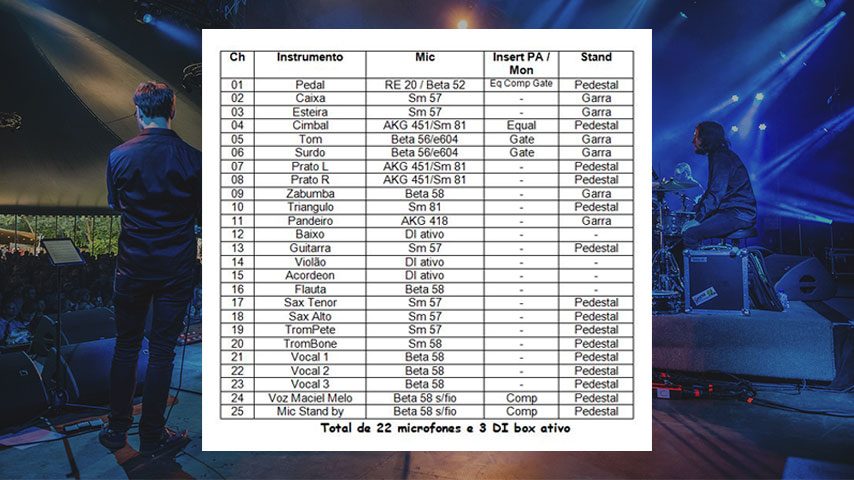
When organizing a concert or musical event, clarity and technical precision are essential to ensure that the performance runs smoothly. In this context, knowing exactly what an input list is and why it is so important for musicians and sound technicians is a must.
From Edgar Vasquez Audiovisual Services In this article we will delve into the concept of the input list, its relevance within the technical rider, how to prepare one for your next performance and answer frequently asked questions related.
What is the audio input list?
The input list is a detailed list of the sound sources such as instruments or vocals of a band that are connected to the audio inputs of a mixing console for the band to be soundtracked or recorded, either at a concert or in a recording studio.
The input list, also known in Spanish as lista de entradas de audio, is an essential component of a band or artist’s technical rider. It is sometimes referred to as a “cue sheet” or “channel list”, and in English it may be called a “patch list“.
In a nutshell, the input list is essential for event sound providers to event sound providers to set up the mixer the mixing console and organize the input channels in a logical way.
Ensure the success of your event with the best sound company in Barcelona. Contract our services today!
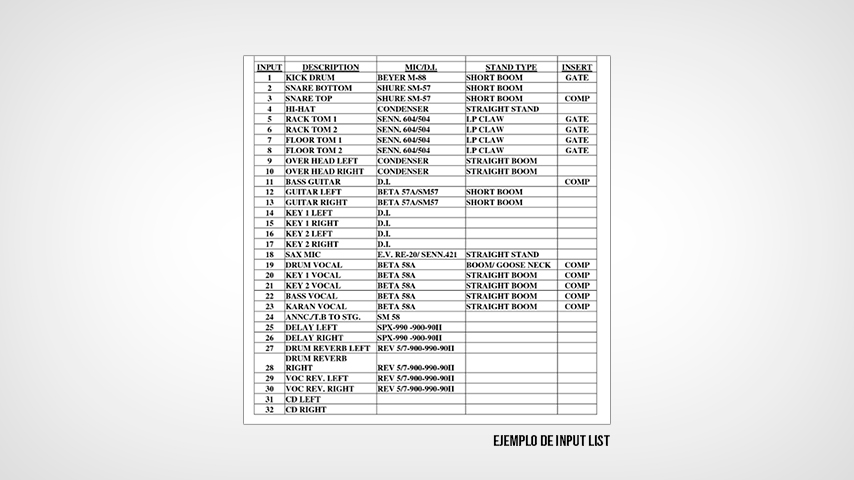
What should a band's input list include?
A complete and detailed input list is essential for the successful preparation and execution of any musical event. To create an input list properly it must include:
1. Item number or input channel.
Assigning each sound source to a specific channel on the mixing console is essential, as it simplifies its identification and management during the event. It is important to list these channels in ascending order, starting from one upwards, to efficiently organize the signal flow and facilitate the task of the sound technicians.
Name of the instrument.
It is important to detail the name of the instrument, including any specific variants it may have, such as “electric” guitar, “alto” saxophone, or “electric” bass. Providing this information clarifies the nature of the sound for technicians, allowing them to understand how it should be properly processed and amplified.
Microphone model.
Specifying the model and brand of microphone is crucial so that sound technicians can prepare the material in advance. Although a technical rider usually requests professionally recognized microphone brands, this detailed information facilitates the research of specifications and features, especially for less experienced technicians, ensuring optimal sound capture during the presentation.
4. Type of support.
Identifying the type of stand, from a traditional microphone stand to special stands adapted to the instruments, is essential to ensure an efficient and agile stage setup. Knowing these details in advance facilitates the work of the technicians and contributes to a smooth transition during the preparation of the event.
5. Type of effect or processor.
It is essential to specify the required audio effects, such as reverb, delay, chorus, tremolo, flanger, and phaser, as well as dynamic effects such as compressors and signal processors such as noise gates. This information allows sound engineers to pre-configure professional audio mixers. professional audio mixers and prepare and prepare the necessary equipment to achieve the desired sound quality during the performance.
Discover Our Event Sound Service
From inspiring conferences to unforgettable shows, we sound every moment with exceptional quality, making your event stand out!
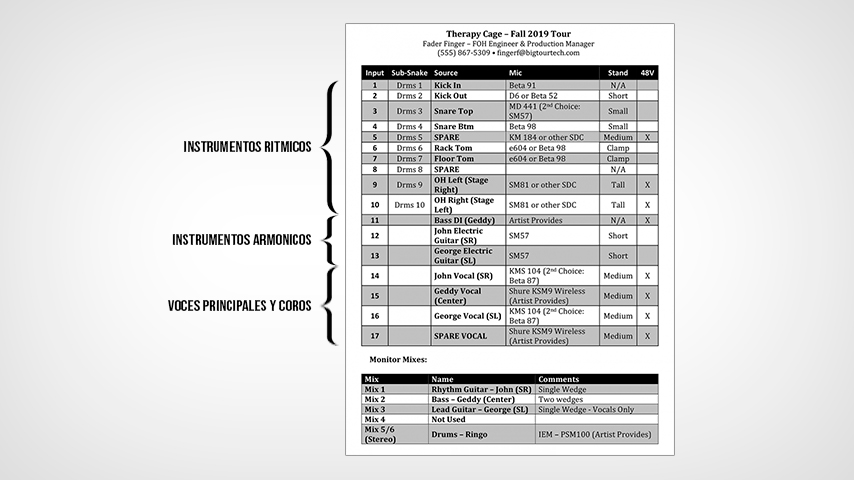
How to make an input list for a performance?
The best way to make an input list for your live performance technical rider is to organize your sound sources into categories, as this is also the way that sound engineers sound engineers audio inputs into the mixer by groups.
1. Rhythmic Percussion Instruments
Rhythmic percussion instruments are fundamental in musical creation, as they establish the pulse and rhythmic base for the development of musical pieces. In the initial configuration of an input list for a concert or performance, the drums usually occupy the first place, given their importance and centrality in the rhythm section.
Depending on the specific needs of the band or musical genre, the input list may include a variety of additional rhythm instruments. From minor percussion instruments such as maracas, triangle, cymbals, cowbell, claves, tambourine, to more resonant instruments such as timbales, bongos, gongs and congas (tumbadoras).
2. Harmonic instruments
Secondly, we have the harmonic instruments, characterized by their capacity to produce two or more notes at the same time, forming chords. Commonly, bass and guitar are the first harmonic instruments listed after drums in percussion.
In addition to these, other harmonic instruments such as keyboard, piano, organ, harp, lute, cuatro, ukulele and violin are frequently included in the input list. Each of these instruments brings a unique texture and color to the musical ensemble, allowing for a rich elaboration of the harmony that underpins the melodies and enriches the overall listening experience.
3. Melodic instruments
Melodic instruments occupy the third place in the hierarchy of the input list. Within this group, instruments such as the saxophone and clarinet stand out for their expressiveness and melodic capacity. They are also joined by other melodic instruments such as the trombone, tuba, pan flute, recorder, oboe and bassoon.
These instruments excel primarily in accompanying and reinforcing the main melody, thus facilitating tuning. Second to contrast and complement the melody, enriching the musical texture. And third in creating introductions that set the tone for the voice.
4. Lead and backing vocals.
Although vocals can be seen as melodic elements, they are classified separately due to their usual position at the end of the list of instruments in a band or musical group. Typically, it begins with the main voice, followed by choruses or secondary voices that provide harmonic and textual support to the main melody.
5. DJ mixers.
Finalizing the list of elements, after instruments and vocals, if the performance includes a DJ, backing tracks, metronome or clapperboard, these are listed at the end of the input list. Generally, they require only a direct box or an auxiliary input connection on the mixing console.
Ensure the success of your event with the best professional sound company. Contract our services today!
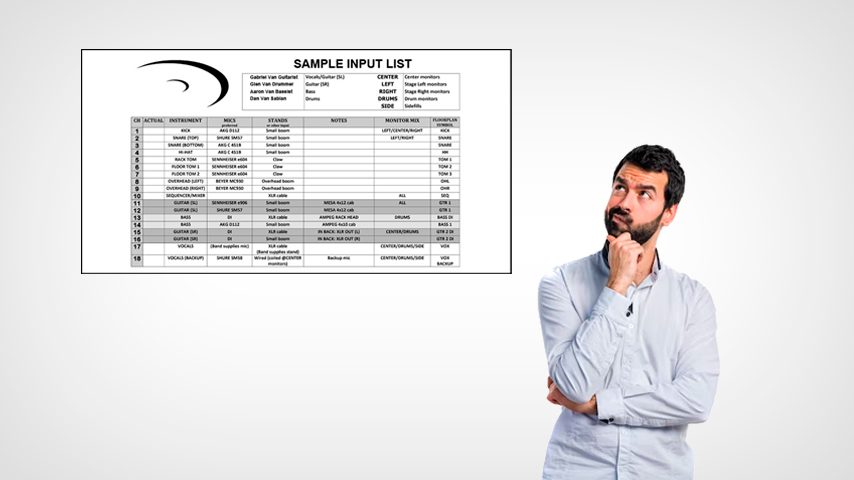
Queries related to the input list
1. What is a technical rider for bands?
A technical rider for bands is an essential document that details all technical and logistical that details all the technical and logistical needs required by a band for its performance. It includes specifications for sound, lighting, stage, and often, catering and accommodation requirements.
The purpose of the technical rider is to ensure that the musicians have everything they need for their performance, from specific equipment to the stage layout, facilitating a smooth performance.
2. What is the backline?
The backline refers to the set of musical instruments and equipment provided by the concert venue or event organizers. This includes amplifiers for guitars and basses, drums, keyboards, and other specific instruments requested by artists.
The backline is crucial to ensure that musicians have the necessary equipment for their performance, especially when they are traveling and cannot bring all their own equipment.
3. What is the stage plot?
The stage plot is a graphic diagram showing the precise position of the musicians, their instruments, and technicaltheir instruments, and the technical equipment on stage. This document provides sound technicians and venue staff with clear guidance on how the stage should be set up.
The stage plot is an ideal stage plan to meet the band’s preferences and requirements. It facilitates communication and helps to avoid confusion during setup and scene change.
4. What is an audio mixer?
An audio mixer is an essential piece of equipment in music production and live essential piece of equipment in music production and. It allows you to mix, process, and route multiple incoming audio signals, such as vocals, instruments, and other sounds, creating a balanced and cohesive audio output.
Mixers can be analog or digital and offer various functions, such as equalization, effects, and signal routing, essential to achieve the desired sound quality.
5. What is an output list?
The output list is a complementary document to the input list, which details all the audio outputs from the mixing console to the different output devices, such as loudspeakers, stage monitors, and recording systems.
The output list helps sound engineers organize and direct the flow of audio signals efficiently, ensuring that the sound arrives correctly at each destination, whether for the audience in the venue or for live recordings.
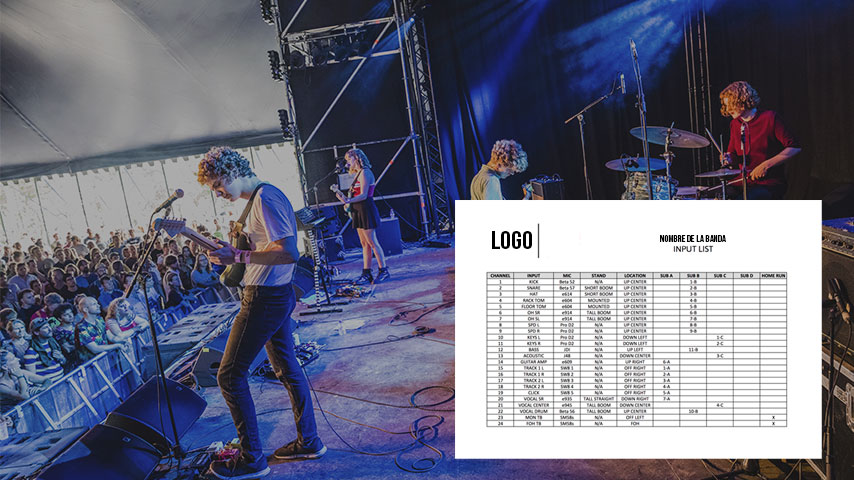
Advantages of the input list for concerts
The input list is, without a doubt, an indispensable tool in the planning and execution of musical events. Some of its most outstanding benefits are:
- Efficient preparation: Allows sound technicians to prepare the necessary equipment in advance.
- Improves sound quality: Helps optimize the sound mix for each performance.
- Minimizes technical problems: Reduces the likelihood of mishaps during the concert.
- Streamlines sound testing: Facilitates quick setup and adjustment during sound testing.
- Sound customization: Allows specific settings for each instrument or voice, enhancing the listening experience for the audience.
By providing clear and detailed guidance for sound technicians, it ensures that every element of the show is captured and amplified correctly, contributing to an unforgettable experience for both performers and audience.
If this tour through the fascinating universe of professional sound has captured your interest, remember that it was Edgar Vasquez Audiovisual Services in Barcelona who shared with you this valuable information. Explore more publications, where you will find more enriching and useful content.
Trust the leading company in professional sound to make your event a success. Contact us today!
RELATED ITEMS
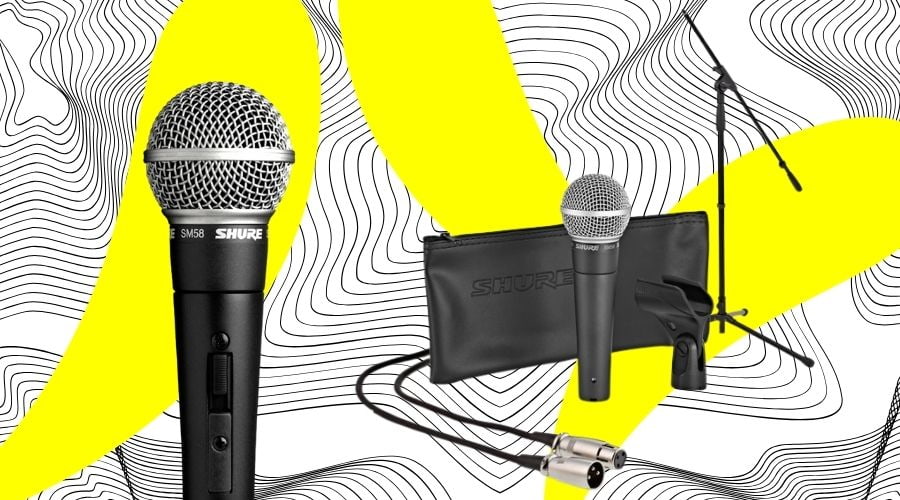
How to rent handheld microphones for your events?
Discover the advantages of renting handheld microphones for your events.
How to achieve guaranteed quality, flexibility and technical support.

5 Key aspects of digital sound mixer rental
Guarantee the success of your event with the rental of digital sound tables.
Complete solutions and professional assistance.
Contact us!
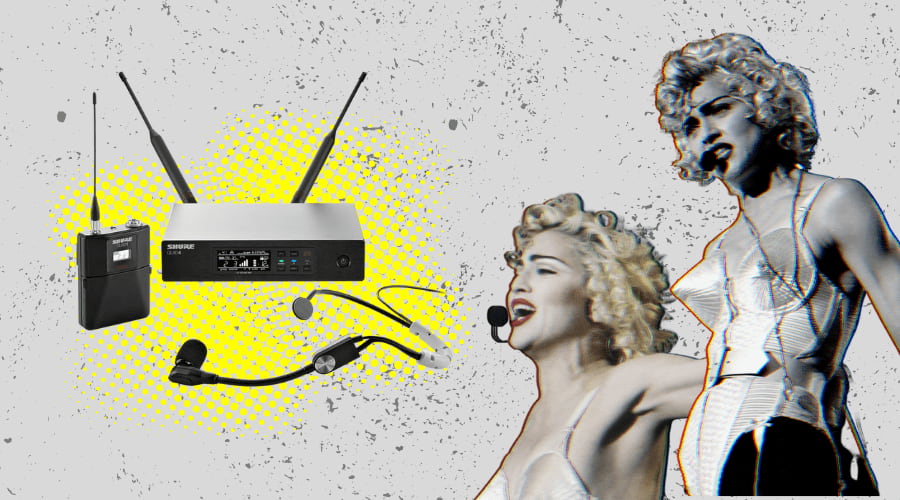
How to rent headset microphones for events?
Learn how to rent headset microphones like an event expert: reduce costs, access advanced technology and technical support.
Make this publication reach more people
Newsletter
¡Suscríbete ahora y mantente al día con nuestras últimas noticias y ofertas exclusivas en nuestro boletín informativo!
FEATURED ARTICLES
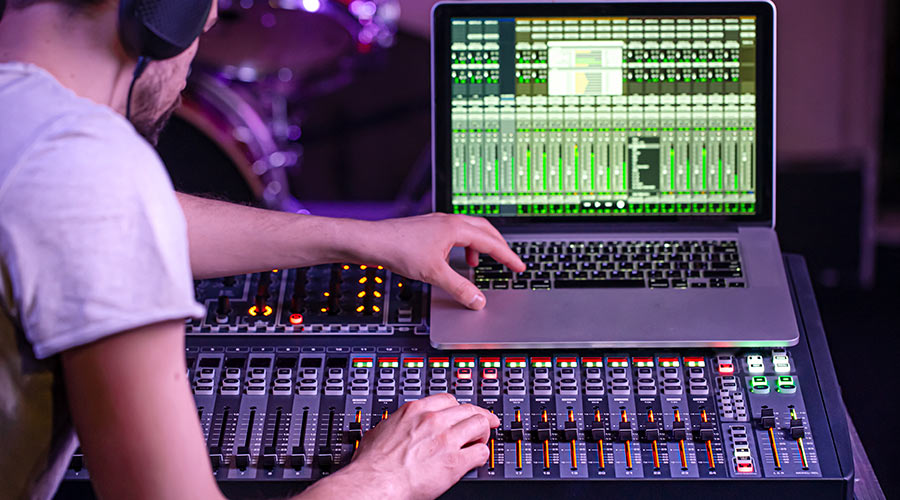
What job does a sound technician do and how much does he/she earn?
Discover how to become a sound technician and the job opportunities in the event, radio, TV and film sound industry.

What is a Giant LED Screen and how does it work?
Discover what an LED Screen is and how they work for events and advertising. Explore its unique and brilliant visual impact!

Organizing corporate events: Everything you need to know
Discover what corporate events are, their strategic value, types and examples. Learn how to organize them in exceptional spaces in Spain.
